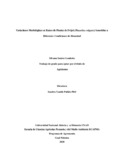Please use this identifier to cite or link to this item:
https://repository.unad.edu.co/handle/10596/34235Full metadata record
| DC Field | Value | Language |
|---|---|---|
| dc.contributor.advisor | Pulido Pulido, Sandra Yamile | - |
| dc.coverage.spatial | udr_-_Cali | spa |
| dc.creator | Suárez Londoño, Silvana | - |
| dc.date.accessioned | 2020-05-27T22:04:04Z | - |
| dc.date.available | 2020-05-27T22:04:04Z | - |
| dc.date.created | 2020-04-30 | - |
| dc.identifier.uri | https://repository.unad.edu.co/handle/10596/34235 | - |
| dc.description.abstract | El déficit hídrico afecta los cultivos causando pérdidas de cosechas y disminución en la producción de alimentos, que conlleva a la inseguridad alimentaria. En el trópico el agua es el factor más limitante en la producción agrícola, la cual se reduce 20% por cada cuatro (4) años de sequía. Las plantas activan mecanismos de sobrevivencia como respuesta al estrés por sequía; uno de estos mecanismos es el aumento de área y longitud de raíces, con los que la planta explora un volumen mayor de suelo para maximizar la absorción de agua intersticial. Estudios realizados en varias especies vegetales sometidas a estrés por sequía, muestran que el aumento en diámetro y longitud de raíces está relacionado con tolerancia a sequía. El objetivo planteado fue identificar características fenotípicas de tolerancia al estrés hídrico en la raíz de dos líneas de fríjol (Phaseolus vulgaris), a diferentes condiciones de humedad y diferentes profundidades bajo invernadero con el método de tubos, para alcanzar este objetivo se midió la longitud y diámetro de las raíces de dos líneas de fríjol Ser 16 tolerante a y Tío canela susceptible a sequía. Con esta investigación se concluyó que las líneas Ser16 y Tío canela, sometidas a diferentes condiciones de humedad, presentan un sistema radical profundo, con longitudes sobresaliente y raíces finas en la superficie del suelo tanto en sequía por déficit como en exceso de agua, son atributos importantes para la selección de genotipos tolerantes a sequía por déficit como por exceso de agua y que la metodología utilizada es adecuada para evaluar características fenotípicas de tolerancia a estrés hídrico. | spa |
| dc.format | otros | |
| dc.title | Variaciones morfológicas en raíces de plantas de Frijol (Phaseolus vulgaris) sometidas a diferentes condiciones de humedad. | |
| dc.type | Proyecto aplicado | |
| dc.subject.keywords | Efectos fisiológicos, tolerancia a estrés,Fríjol, Humedad del suelo, Fisiología vegetal | spa |
| dc.description.abstractenglish | The water deficit affects crops causing losses and decreased food production, which causes food insecurity. In tropics, water is the most limiting factor in agricultural production, which is reduced by 20% for every four (4) years of drought. Plants activate survival mechanisms in response to drought stress; One of these mechanisms is increasing in area and length of roots, with which the plant explores a greater volume of soil to maximize the absorption of interstitial water. Studies in several plant species subjected to drought stress show that the increase in root diameter and length is related to drought tolerance. The objective was to identify phenotypic characteristics of tolerance to water stress at the root of two bean lines (Phaseolus vulgaris), at different humidity conditions and different depths under greenhouse with the tube method, to achieve this objective the length was measured and Root diameter of two “Ser16” bean lines tolerant A and “Tio cinnamon” susceptible to drought. With this investigation, it was concluded that the “Ser16” and “Tío cinnamon” lines, subject to different humidity conditions, have a deep radical system, with outstanding lengths and fine roots on the soil surface both in deficit drought and in excess of water, these are important attributes for the selection of drought-tolerant genotypes due to deficit such as excess water, and, the methodology used is adequate to evaluate phenotypic characteristics of tolerance to water stress. | spa |
| dc.subject.category | Agronomía | spa |
| Appears in Collections: | Agronomía | |
Files in This Item:
| File | Description | Size | Format | |
|---|---|---|---|---|
| ssuarezl.pdf | 1.3 MB | Adobe PDF |  View/Open |
Items in DSpace are protected by copyright, with all rights reserved, unless otherwise indicated.
